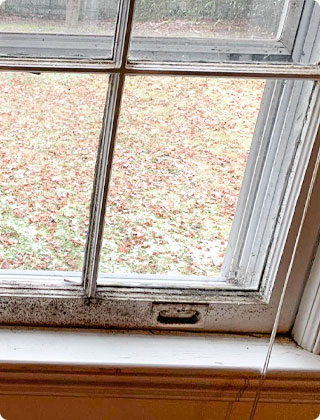MENU


Maintaining an interior humidity level to prevent mold is essential. Living in a comfortable and healthy environment is the aim. Elevated relative humidity not only causes discomfort but also fosters mold growth. This could harm both your house and your health.
In this article, we will look at the most important ways for mold growth, humidity control, and mold avoidance. Furthermore, symptoms of the so-called humidity mold, methods for testing and controlling humidity, and strategies to treat mold issues if they emerge are covered.
Indoor humidity refers to the amount of moisture present in the air within your home. Balancing humidity is essential for various reasons. A few of these reasons are for occupant comfort, preventing structural damage, and inhibiting mold growth. Understanding the ideal humidity range is the first step in maintaining a healthy indoor environment.
At what humidity does mold grow? The recommended indoor humidity level falls between 40% and 60% according to professional mold remediation experts. This range is optimal for preventing mold growth. Deviations from this range can lead to various issues. Thus, it is a need to check and control indoor humidity levels.
Your family's needs will determine the appropriate humidity level for your house. It will depend on the season, the clothing you're wearing, and the area where your family feels most at ease.
According to research, a home's ideal relative humidity ranges from 40% to 60%. Nonetheless, levels ought to be maintained below 50%. Experts do this to prevent the development and spread of mold from humidity. Again, though, feel free to change this to your comfort level. The absolute humidity outside should likewise correspond with the relative humidity indoors.
Various factors can cause high humidity levels in a home. One common contributor is inadequate ventilation, which prevents proper air circulation and the escape of moisture. Activities such as cooking, showering, and even breathing release moisture into the air, and without adequate ventilation, this moisture can accumulate indoors. Leaks or water intrusion, whether from a roof, plumbing, or foundation issues, can also lead to increased humidity levels. Additionally, poorly sealed windows and doors may allow humid outdoor air to enter the home. Lack of insulation can result in temperature differentials, causing condensation and elevated humidity. In some cases, using appliances like humidifiers or having an oversized HVAC system can unintentionally introduce excess moisture. Addressing these issues through proper ventilation, repairing leaks, and maintaining suitable indoor temperatures can help regulate and reduce humidity levels in a home.
The health and well-being of everyone are enhanced when the interior humidity levels in your home are maintained within the optimal range. Achieving the ideal balance between too high and low humidity also improves the quality of your house.
Several signs show high indoor humidity. The most obvious signs are condensation on windows and musty odors. Other than that, damp spots on walls or ceilings and the presence of mold are also visible. Recognizing these signs early on allows for prompt action to prevent further complications.
If you notice dew on your windows, this is one of the biggest indicators that your home is experiencing excessive humidity levels. The interior of the windows in your house shouldn't have condensation on them. If any, it will only be very close to the borders of your window frame when the humidity level is healthy. Anything more on the interior door or window means there's a problem with humidity.
Yes, testing your home's humidity levels is a straightforward process. Hygrometers are available and can measure the amount of moisture in the air. Regular monitoring enables homeowners to identify potential issues and take corrective measures.
Tests like these are meant to serve as a preliminary assessment. It's crucial to seek the help of a mold testing company. This is due to the multitude of possible health consequences and problems with house quality. Hiring a professional entitles you to routine checks, as well as help in controlling the humidity levels in your house. Other than that, they can also give advice on any necessary system modifications. This will assess the house for many other air quality issues and risks.
When you realize that your house isn't within the appropriate range for humidity, you should come up with a wise plan. Together with an expert like 02 Mold Testing of Bethesda, MD, your space will be able to achieve the standard humidity level.
Controlling indoor humidity involves implementing various effective strategies. Such ways include proper ventilation, using dehumidifiers, fixing leaks, and ensuring adequate insulation. These measures help maintain a healthy and mold-resistant environment.
Keeping your home's humidity between 40 and 60 percent will lower the likelihood that anyone in your family will become sick. It will lessen the likelihood of drying out and warping your house due to moisture damage.
If you find mold growth in your Bethesda, MD, home, you must move to resolve the problem.
Mold can be harmful to your health and can cause structural damage to your property. It is always crucial to get guidance from mold professionals who specialize in Mold Testing and cleanup if you are still determining how to begin.
Our knowledgeable staff specializes in 02 Mold Testing of Bethesda, MD, which is tailored to your home's specific needs. We identify the sources of the mold, assess the extent of the infestation, and suggest effective treatments to prevent recurrence using cutting-edge technology.
Understanding and managing indoor humidity levels is essential for maintaining a healthy and mold-free home. By adhering to recommended humidity levels, monitoring for signs of excess moisture, and taking proactive measures to control humidity, homeowners can create a comfortable and safe living environment for themselves and their families.
The best mold testing can be accessible from 02 Mold Testing of Bethesda, MD if you or a loved one is exhibiting several of the symptoms or it is evident that your space is outside of the ideal range of the standard humidity. Our goal is to provide everyone with clean, healthy air to breathe. The most important thing to keep in mind when it comes to humidity is that, if left unchecked, both high and low humidity levels can have an impact on your home and health.